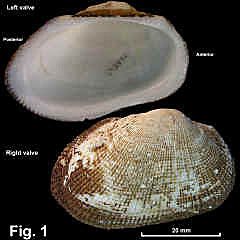|
|
ARCIDAE |
|
|
|
Barbatia parvivillosa (Iredale, 1939) Description: Equivalve, inequilateral. Shape elongate, umbones in front of midline, elevated, widely separated. Hinge line straight. Posterior end extended, both ends broadly rounded. Ventral margin straight or sinuate, byssal notch gaping. Hinge with large teeth at ends becoming smaller towards middle. Ligament external, spread over ridged area between umbones. Interior with marginal edge smooth, glossy; anterior and posterior muscle scars almost circular; sometimes widely spaced radial grooves present; colour white. Exterior sculpture of beaded radial ridges and irregular, coarse, concentric growth ridges. Periostracum short, brown, only occasionally developing bristles. Shell colour white; in life obscured by periostracum. Size: Up to 72 mm in length. Distribution: Endemic to Australia: northern Western Australia, across northern Australia and southwards to Sydney, NSW. Habitat: Lives on rocky shores attached by the byssus to solid substrates. Moderately common. Comparison: Compared with B. pistachia, this species has the posterior end longer and the hinge line only about half the shell length. The periostracum is short, only occasionally developing bristles, with the interior colour white. Remarks: Another species of Barbatia uncommonly found in northern NSW is Barbatia foliata (Forsskål, 1775) (synonym Abarbatia corallicola Iredale, 1939). This tropical species has an Indo-west Pacific distribution, and in Australia is known from northern WA around northern Australia, to Qld and northern NSW. It is characterised by a very dense periostracum that is longer at the posterior end (Garcia & Oliver, 2008). Fig. 1: Minnie Water, East of Grafton, NSW. (C.093976)
|
|
